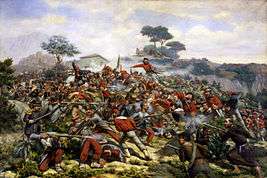Battle of Calatafimi
| Battle of Calatafimi | |||||||
|---|---|---|---|---|---|---|---|
| Part of The Expedition of the Thousand | |||||||
 Skirmish at Calatafimi | |||||||
| |||||||
| Belligerents | |||||||
|
|
| ||||||
| Commanders and leaders | |||||||
| Giuseppe Garibaldi [4] | Francesco Landi [4] | ||||||
| Strength | |||||||
| ca. 1,200 [2][3] | ca. 3,000 [1][2] | ||||||
| Casualties and losses | |||||||
|
32 killed [5][6] 160-182 wounded [5][6] ~200 killed & wounded [7] |
36 killed [2][5][7] 148 wounded [5][7] 1 cannon and 6 captured[4][7] | ||||||
The Battle of Calatafimi was fought on May 15, 1860 between Giuseppe Garibaldi's volunteers and the troops of the Kingdom of the Two Sicilies at Calatafimi, Sicily, as part of the Expedition of the Thousand (Italian: I Mille).
Prelude
Four days prior to the battle, the Mille had landed at Marsala, on board the ships Il Piemonte and Il Lombardo. Francesco Crispi, among others, landed before the Mille on Sicily to raise support among the locals for the Mille. On May 14, at Salemi, Garibaldi announced that he was assuming dictatorship over Sicily in the name of King Victor Emmanuel II of Sardinia.
Battle
The Battle of Calatafimi took place on the hill Pianto Romano, near the namesake town. The battle was inconclusive, but served to boost the morale of the Mille and, at the same time, depress the Neapolitans, who, ill guided with their often corrupted officers, started to feel themselves abandoned. During the battle, Garibaldi is said to have uttered the famous battle cry "Qui si fa l'Italia o si muore" ("Here we make Italy, or we die").
Due to the battle, the ranks of the Mille enlarged to 1,200 with local men joining.
Aftermath
With the help of a popular insurrection, on May 27 they laid siege to Palermo, the island's capital. The city was defended by some 16,000 men, but they were under the confused and timid direction of general Ferdinando Lanza, aged 75.
While two columns of Garibaldines attacked the external perimeter, part of the population, strengthened by 2,000 prisoners liberated from the local jails, rose against the garrison. When his troops were driven back from most of their positions, Lanza ordered them to bombard the city for three days, provoking the deaths of 600 civilians. By May 28, Garibaldi controlled much of the city and declared the Bourbon authority deposed. The following day, a desperate Neapolitan counteroffensive was driven back, and Lanza asked for a truce. However, when a reinforcement party of well equipped and well trained troops arrived in the city, the situation became very serious for Garibaldi, who was saved only by Lanza's decision to surrender. Through the mediation of a British admiral, an armistice was signed and the Neapolitan fleet abandoned the port.
Sources
- 1 2 3 Rüstow, Wilhelm (1867). Die Feldherrnkunst des neunzehnten Jahrhunderts. Zurich.
- 1 2 3 4 5 Hartwig, Otto (1869). Aus Sicilien: Vol.II. Kassel.
- 1 2 3 Trevelyan, George Macaulay (1912). Garibaldi and the Thousand. London.
- 1 2 3 von Meerheimb, Richard (1865). Von Palermo bis Gaëta. Dresden.
- 1 2 3 4 Esercito. Corpo di stato maggiore. Ufficio storico. (1982). Il Generale Giuseppe Garibaldi. Rome.
- 1 2 Deutsche Revue (1900). Deutsche Revue: Vol.XXV. Deutschland.
- 1 2 3 4 Forbes, Charles Stuart (1861). The campaign of Garibaldi in the Two Sicilies. Edinburgh.
See also
![]() Media related to Battle of Calatafimi at Wikimedia Commons
Media related to Battle of Calatafimi at Wikimedia Commons

